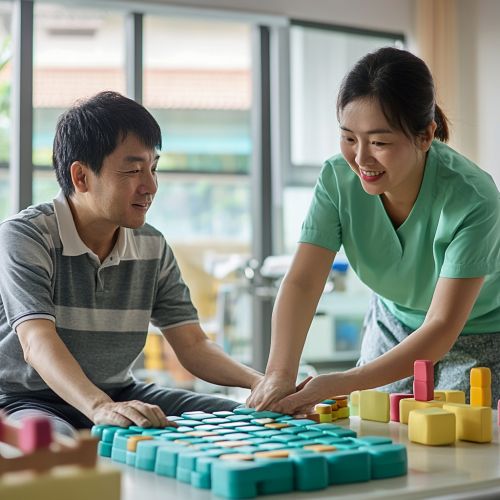Cognitive Mechanisms of Rehabilitation
Introduction
Cognitive mechanisms of rehabilitation refer to the mental processes and strategies employed to restore cognitive function following injury, illness, or other impairments. This field encompasses a variety of techniques and approaches aimed at improving cognitive abilities such as memory, attention, executive function, and language skills. Rehabilitation can be crucial for individuals recovering from conditions like traumatic brain injury (TBI), stroke, neurodegenerative diseases, and mental health disorders.
Cognitive Rehabilitation Therapy (CRT)
Cognitive Rehabilitation Therapy (CRT) is a structured set of therapeutic activities designed to improve cognitive functioning. CRT can be divided into two main approaches: restorative and compensatory.
Restorative Approaches
Restorative approaches aim to restore lost cognitive functions through repetitive exercises and tasks. These tasks are designed to stimulate neuroplasticity, the brain's ability to reorganize itself by forming new neural connections. Techniques include:
- **Cognitive Exercises**: Tasks such as puzzles, memory games, and problem-solving activities.
- **Computer-Assisted Cognitive Rehabilitation**: Software programs that provide structured cognitive exercises.
- **Neurofeedback**: A technique that uses real-time monitoring of brain activity to teach self-regulation of brain function.
Compensatory Approaches
Compensatory approaches focus on teaching strategies to compensate for cognitive deficits. These strategies often involve the use of external aids and environmental modifications. Techniques include:
- **Memory Aids**: Use of calendars, planners, and electronic devices to aid memory.
- **Environmental Modifications**: Changes in the living environment to reduce cognitive load, such as labeling items and creating routines.
- **Task Simplification**: Breaking down complex tasks into simpler, manageable steps.


Mechanisms of Neuroplasticity
Neuroplasticity is a fundamental concept in cognitive rehabilitation. It refers to the brain's ability to adapt and change in response to experience and learning. Key mechanisms include:
- **Synaptic Plasticity**: The strengthening or weakening of synapses, which are the connections between neurons.
- **Neurogenesis**: The formation of new neurons, particularly in the hippocampus, a region critical for memory.
- **Functional Reorganization**: The brain's ability to shift functions from damaged areas to healthy areas.
Cognitive Domains in Rehabilitation
Cognitive rehabilitation often targets specific cognitive domains, each of which involves distinct mental processes.
Memory
Memory rehabilitation focuses on improving both short-term and long-term memory. Techniques include:
- **Spaced Retrieval**: Practicing recall of information at increasing intervals.
- **Mnemonics**: Using associations and visual imagery to enhance memory.
Attention
Attention rehabilitation aims to improve the ability to focus and sustain attention. Techniques include:
- **Attention Process Training (APT)**: Structured tasks designed to improve different types of attention, such as sustained, selective, and divided attention.
- **Mindfulness Training**: Techniques to enhance present-moment awareness and reduce distractions.
Executive Function
Executive function rehabilitation targets higher-order cognitive processes such as planning, decision-making, and problem-solving. Techniques include:
- **Goal Management Training (GMT)**: Teaching individuals to set, monitor, and achieve goals.
- **Cognitive Behavioral Therapy (CBT)**: Addressing dysfunctional thinking patterns to improve decision-making and problem-solving.
Language
Language rehabilitation, often referred to as speech-language therapy, focuses on improving communication skills. Techniques include:
- **Aphasia Therapy**: Targeted exercises to improve language comprehension and production.
- **Augmentative and Alternative Communication (AAC)**: Use of devices and systems to aid communication.
Neuropsychological Assessment
Neuropsychological assessment is a critical component of cognitive rehabilitation. It involves a comprehensive evaluation of cognitive function using standardized tests. Key areas assessed include:
- **Intelligence**: General cognitive ability.
- **Memory**: Both verbal and non-verbal memory.
- **Attention**: Various types of attention, including sustained and selective attention.
- **Executive Function**: Planning, problem-solving, and cognitive flexibility.
- **Language**: Comprehension, expression, and naming.
Rehabilitation in Specific Conditions
Cognitive rehabilitation is tailored to the specific needs of individuals with different conditions.
Traumatic Brain Injury (TBI)
TBI often results in diffuse cognitive deficits. Rehabilitation focuses on:
- **Restoring Attention and Memory**: Using both restorative and compensatory techniques.
- **Behavioral Interventions**: Addressing behavioral and emotional changes post-injury.
Stroke
Stroke can cause focal cognitive deficits depending on the area of the brain affected. Rehabilitation focuses on:
- **Language Rehabilitation**: Particularly for individuals with aphasia.
- **Motor-Cognitive Integration**: Combining physical and cognitive exercises to improve overall function.
Neurodegenerative Diseases
Conditions like Alzheimer's disease and Parkinson's disease involve progressive cognitive decline. Rehabilitation focuses on:
- **Slowing Cognitive Decline**: Using cognitive exercises and environmental modifications.
- **Enhancing Quality of Life**: Implementing strategies to maintain independence.
Mental Health Disorders
Cognitive deficits are common in mental health disorders such as schizophrenia and depression. Rehabilitation focuses on:
- **Cognitive Remediation Therapy (CRT)**: Structured exercises to improve cognitive function.
- **Psychosocial Interventions**: Combining cognitive rehabilitation with social skills training.
Emerging Techniques and Technologies
Advancements in technology are continually shaping the field of cognitive rehabilitation.
Virtual Reality (VR)
VR provides immersive environments for cognitive training, offering realistic and engaging scenarios for rehabilitation.
Brain-Computer Interfaces (BCIs)
BCIs enable direct communication between the brain and external devices, offering potential for innovative rehabilitation techniques.
Transcranial Magnetic Stimulation (TMS)
TMS uses magnetic fields to stimulate specific brain regions, potentially enhancing neuroplasticity and cognitive function.
Challenges and Future Directions
Despite advancements, cognitive rehabilitation faces several challenges:
- **Individual Variability**: Cognitive deficits and recovery trajectories vary widely among individuals.
- **Access to Services**: Availability of specialized rehabilitation services can be limited.
- **Evidence-Based Practice**: Continued research is needed to establish the efficacy of various rehabilitation techniques.
Future directions include:
- **Personalized Rehabilitation**: Tailoring interventions to individual needs using advanced assessment tools.
- **Integration of Technology**: Leveraging emerging technologies to enhance rehabilitation outcomes.
- **Interdisciplinary Approaches**: Combining expertise from various fields to develop comprehensive rehabilitation programs.
See Also
- Neuroplasticity
- Traumatic Brain Injury
- Stroke Rehabilitation
- Cognitive Behavioral Therapy
- Neuropsychological Assessment
